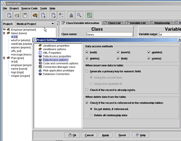SourceCafe
Generate Java Code for Databases
by Curtis Krauskopf
Developing a Web-enabled
database isn't easy. Changes inevitably creep into the
schema after the Java classes have been coded. Likewise,
propagating changes to the architecture of a class structure
is very tedious. In most nontextbook situations, the
net result is a set of Java classes that don't exactly
reflect the database schema and lack consistency in
their architecture.
|
Quick
Facts
SourceCafe is a time-saving
tool that creates Java Servlets, JavaBeans, JSP,
and HTML code and generates compilable code that
communicates intelligently with databases.
EJD
Technologies
|
SourceCafe simplifies database-driven Web development
by creating Java Servlets, JavaBeans, JavaServer Pages
(JSPs), and HTML code. Its biggest strengths are its
abilities to connect to any JDBC-compliant database,
determine the structure of the database automatically,
and then generate compilable code that is able to communicate
intelligently with that database.
The SourceCafe GUI interface allows you to choose from
hundreds of variations of database architectures. This
feature, by itself, becomes an excellent tutorial for
Java beginners that want to try different modeling techniques.
Overall, the GUI is wonderfully laid out, and the oversize
shortcut icons are very easy to hit (see Figure
1)
The technical support from EJD Technologies is first-rate.
When I encountered a problem in which SourceCafe would
throw a null exception when I tried to load the GUI,
they were very responsive to my questions, and they
seemed genuinely concerned that I was having trouble.
After following their instructions and providing some
configuration files, EJD was able to publish a patch
that did fix the problem. That's what I call excellent
support. And unlike most products, the online help for
SourceCafe really is helpful. Almost all of the properties
and their effects are clearly documented.
 |
|
Figure 1. SourceCafe GUI
|
Although the demo version is limited to three tables,
I was able to adequately test SourceCafe's ability to
handle different Java data types automatically because
I picked tables that consisted of a variety of common
MySQL data types.
The source code generated by SourceCafe is excellent.
The code contains both JavaDoc comments and regular
comments. The code is well organized into blocks separated
by blank lines, contains meaningful parameters, and
follows standard code-formatting conventions. Best of
all, it compiles without needing manual changes. Installing
the code can be somewhat of a problem, though. A certain
level of experience is expected from the user in being
able to segregate generated files into appropriate directories.
A wizard that places code in the right place would certainly
be helpful in this step.
When using SourceCafe the first thing you need to determine
is which of the many property settings generates code
that most closely matches a database methodology that
you want to use. You might find a methodology that closely
matches what you want, or you might not care and just
want to generate some Java code that allows you to interface
with the database. In either of these cases, this product
is a real time-saver and generates code automatically
that is compilable without manual changes.
SourceCafe generates a preview of the source code.
This feature definitely helps you determine which property
settings should be used. The preview comes in two forms.
In one form a static sample code page on the GUI shows
a short sample of applying the most important property
settings. In the other form a more comprehensive view
of all generated Java source is available on a special
Previews page.
A Quandary
A tool like this, though, can't possibly account for
every methodology permutation that you could want. In
this case, you can have your own custom code-generation
engine by modifying a template called a FooBarGenerator.
However, this template leads us to the biggest quandary
when trying to determine whether SourceCafe is useful
or not: if I don't like any of the techniques programmed
into SourceCafe and I have to modify the FooBarGenerator,
it's not much more difficult to add a dozen lines of
Java code that interrogate a database schema, and then
I don't have to use SourceCafe at all.
Using SourceCafe in the long run can be problematic.
Currently, manual changes to generated code are lost
the next time code is regenerated. Also, changes in
the database schema cannot be imported into an existing
project. Both of these limitations relegate SourceCafe
to a roll of generating code for prototyping, debugging,
or testing.
If your goal is to be able to generate code quickly
that is able to interface with an existing database
schema, SourceCafe is definitely the best tool to use.
SourceCafe will pay for itself the first time you use
it because it will save you the hassle of creating hand-generated
source files for every table in the schema.
About the Author
| |
 |
| This article was originally published
in the July 2003 issue of JavaPro
magazine. |
Curtis Krauskopf is a software engineer and the president
of The Database
Managers. He has been writing code professionally
for over 20 years. His prior projects include multiple
Web e-commerce Web applications, decompilers for the
DataFlex language, aircraft simulators, an automated
Y2K conversion program for over 3 million compiled DataFlex
programs, and inventory control projects. This
article was written by Curtis Krauskopf (email at  ). ).
|



